BNSF 7345, 692, and 7336 East pass by Andy Cassidy with 49 Cars at Begbie Street near New Westminster, BC at Mile 0.1 on the Southern Railway of BC Railink ( SRY) Fraser Valley Sub on July 30th,
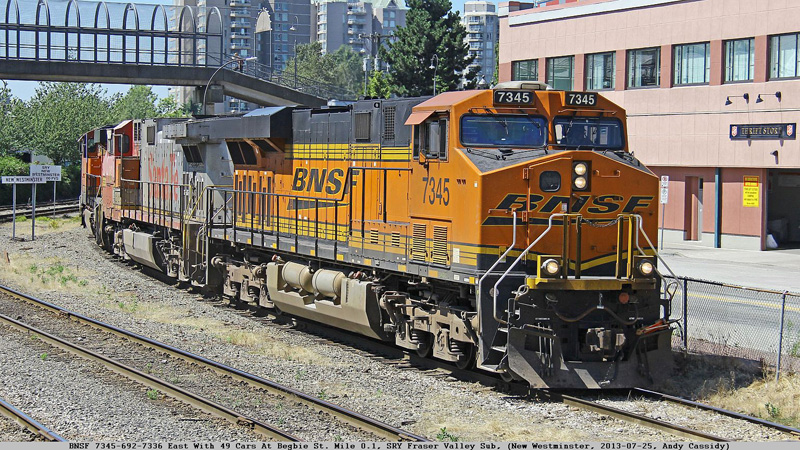
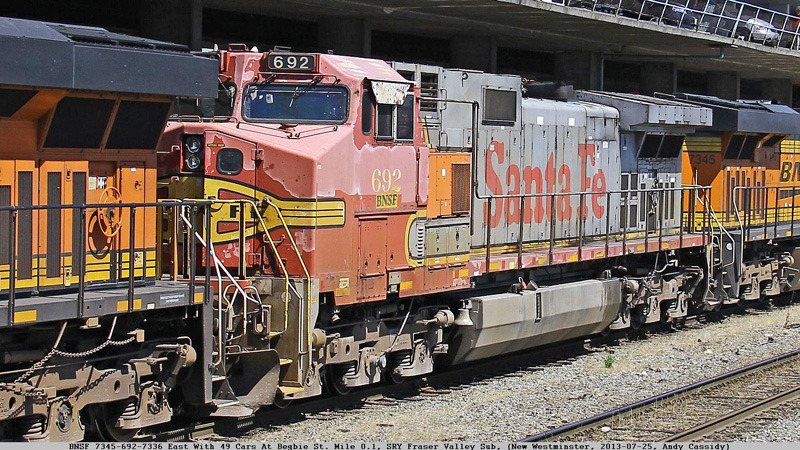
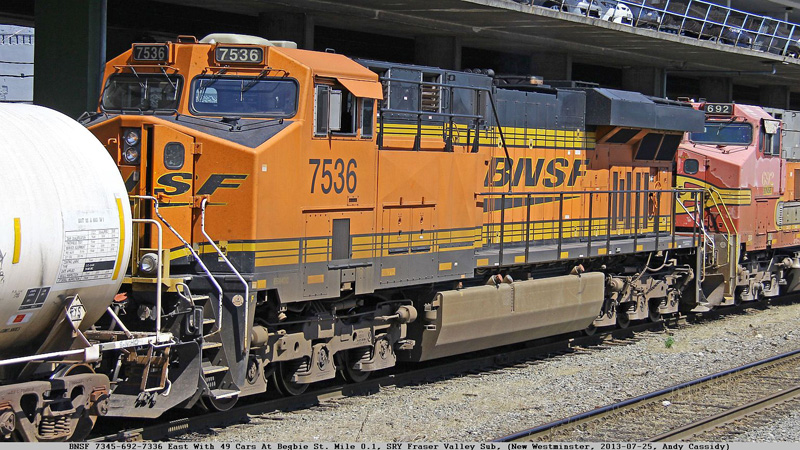
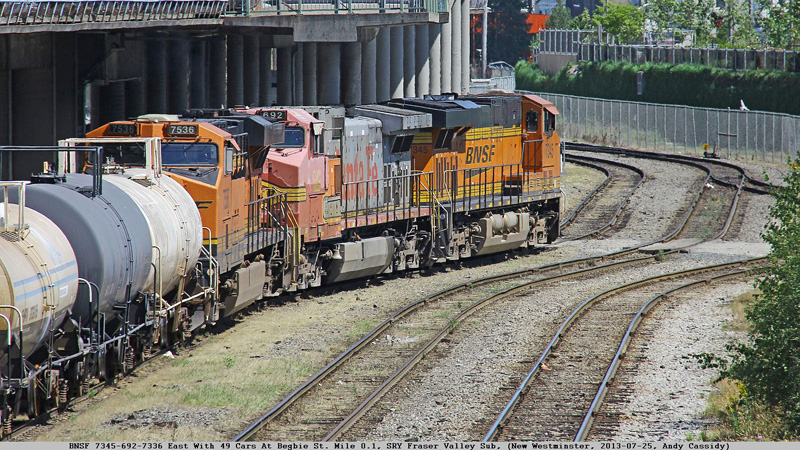
North West Terminal Ltd of Unity, SK and Torq Transloading Inc, a Saskatchewan-based grain company, have leased two ex-BNSF SD40-2s, DLCX 6961 and 6991 (Ex-CN SD40 5054, and CN 5213). The duo arrived in August. They had been using a 4-axle locomotive that proved insufficient to move the heavy loaded cars. The DLCX SD40-2s were shipped by Diesel Locomotive Company Ltd., the same company that shipped CEFX 1507 to the Central Manitoba Railway, in early August,
During the 1990’s ALSTOM had a contract to rebuild 40 CN SD40’s into BNSF SD40-2’s and were numbered 7300-7339, Later renumbered into the 6900 series, BNSF is now retiring the last of them. The DLCX pair were were sitting at the CN engine facility in Stevens Point, WI in July. David Anderson photographed one of these units BNSF 6991 at San Bernadino, CA back in April 2007.
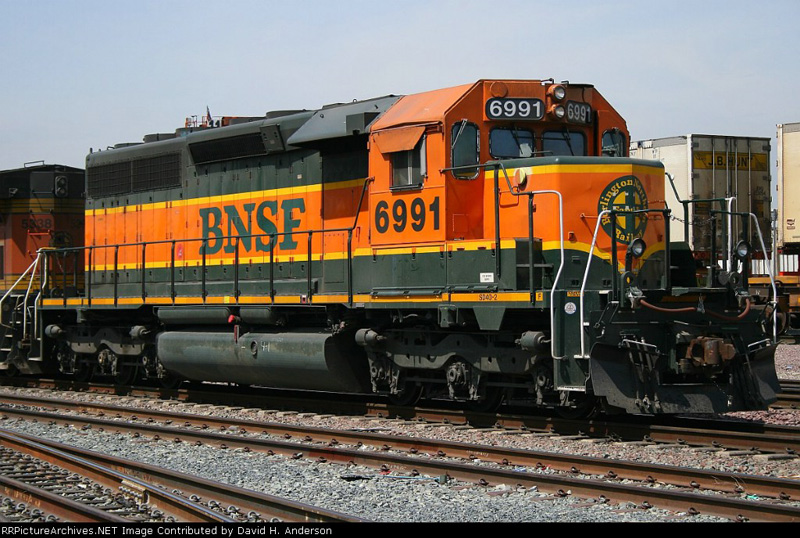
An oil industry located on the Alberta, border and served by the Saskatchewan-based Great Plains Railway, has received an SW1200 from the USA, and which has been renumbered to Locomotive Diesel Services LDSX 121.
In August, Richardson International a grain company in Estavan, SK, leased LTEX GP15-1 1450 from Larry’s Truck Electric.
Great Western Railway has the two GWR B23-7’s (Ex-NS, nee-CR) are on the property with the 4064 in service with the corner windows added. As we went to press, GWR 4062 has an issue in the equipment blower and is getting the new corner windows added. The three MLW’s are in service as well, but GWR M420W 2002 in for top deck overhaul and 2004 will need an engine change-out. The ex-BNSF dash 8W’s are both in service. As well,
Diesel Electric Services (DESX) GP10 8308 (ex-IC nee-Mid South Rail) has been leased to the Great Western Railway for service.
CRLX 2101, a GE 80-Ton switcher arrived at CN's Walker Yard in Edmonton last fall and was in transit to the Alberta Railway Museum. However, the final leg of the move has been delayed ever since. On June 24th, Jesse Acorn caught her at the near diesel shop. Built in 1950 as Stelco #52 in Hamilton, ON, In 1985, the loco became Altasteel with no Number sold many years ago, and spent the end of her career working at Altasteel in Edmonton Alberta, until retired and was donated to the Alberta Railway Museum last year. Now she just needs to get there. Last year 44-ton switcher CN #4 arrived at the museum and was repainted back into its original CN colors. (Jesse Acorn Photo)
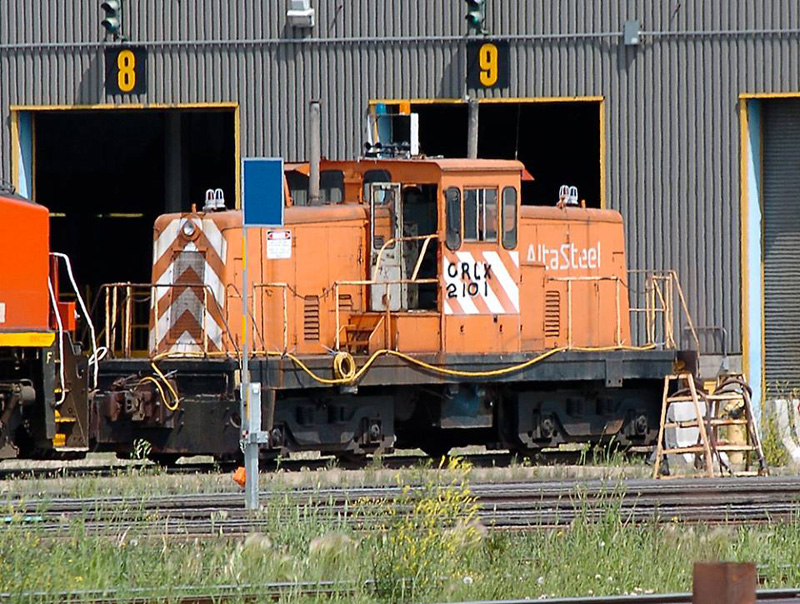
Hudson Bay Railway (HBRY) has leased HLCX SD$0-2 7231 which was photographed at Symington Shop onon July 18th, by Mark Perry, before heading north. At press time, SW100RS 509 is also enroute to HBRY.
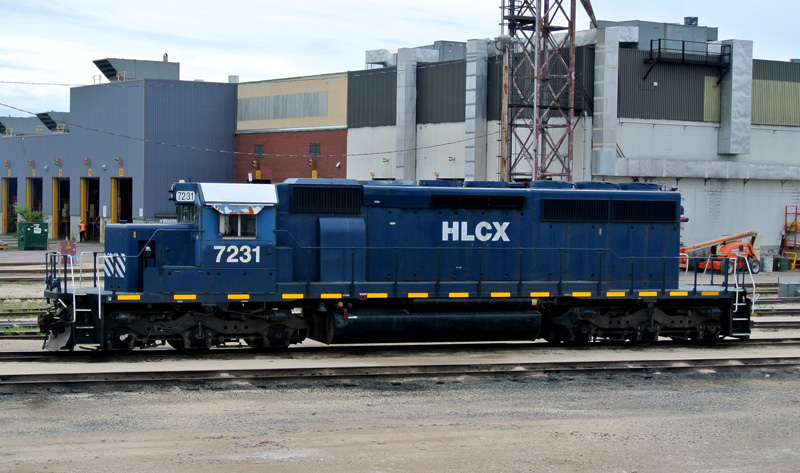
Plagued with mechanical issues since her arrival, RTEX 8153 had been leased to Hudson Bay Mining and Smelting, and is now being returned to the lessor Rail Trusts. While it is mostly in running order, HBM&S took back the parts they stripped from 8161 to keep it going.
During August, the Stewart Southern Railway received new power with GMTX 2237 and 2238 arriving in August heading east towards the SSR August 1st. trailing SSR 1504 and 1505. Both are ex-EMDX units, ex-CR 8027 & 8028, nee-PC 8027 & 8028 and are relettered for Stewart Southern Railway. Mark Perry shot this STEWART SOUTHERN (SSR) train near Richardson SK in early September, with units GMTX 1509-2238-2222-2237.
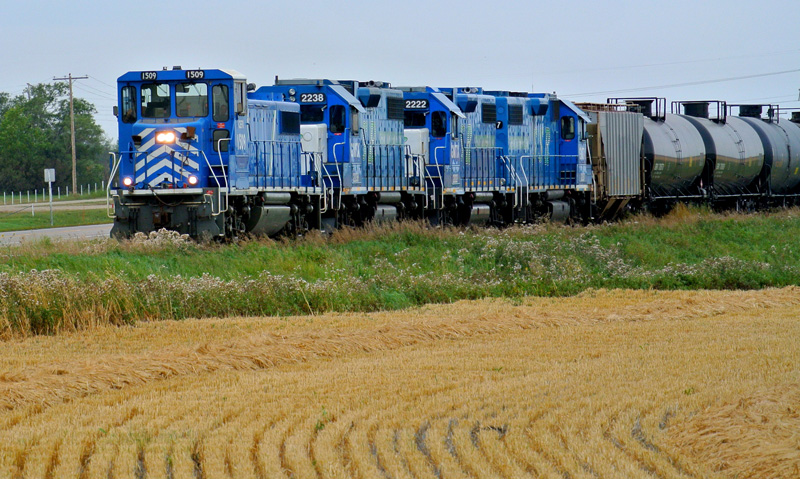
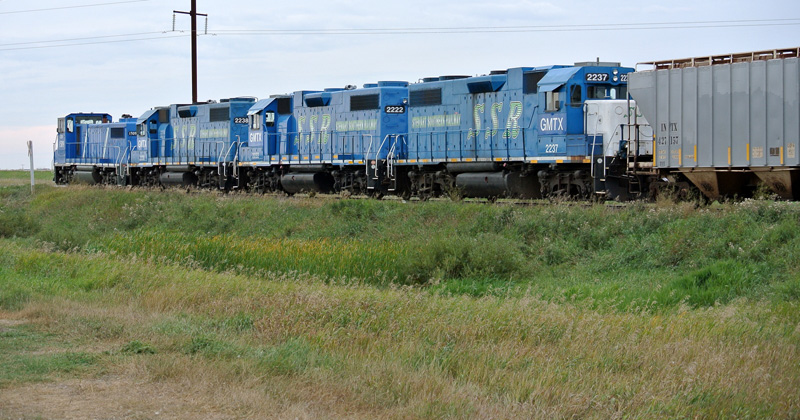
On August 22nd, Jesse Acorn bagged GMTX 2222 at CP's South Edmonton Yard wearing Stewart Southern Railway lettering. SSR is a Saskatchewan shortline that operates about 80 miles of former CP track between Stoughton and Richardson, SK. (HBRY) has leased HLCX SD$0-2 7231 which was photographed at Symington Shop onon July 18th, by Mark Perry, before heading north.

Mark Perry snapped LLPX GP15-1 1502 in Page, MB August 23rd. The former CSX unit is on lease as the switch engine at the grain elevator located there. They previously had used BRC GP7 477, which for the last three years has been is working at CON AGRA (Peavy Grain) in Grand Forks, ND.

Belt Railway of Chicago GP7 477 at the BRC Clearing Yard back in 1983. This Geep had worked in Manitoba, Canada and now works at CON AGRA (Peavy Grain) in Grand Forks, ND. (Alan Gaines photo).
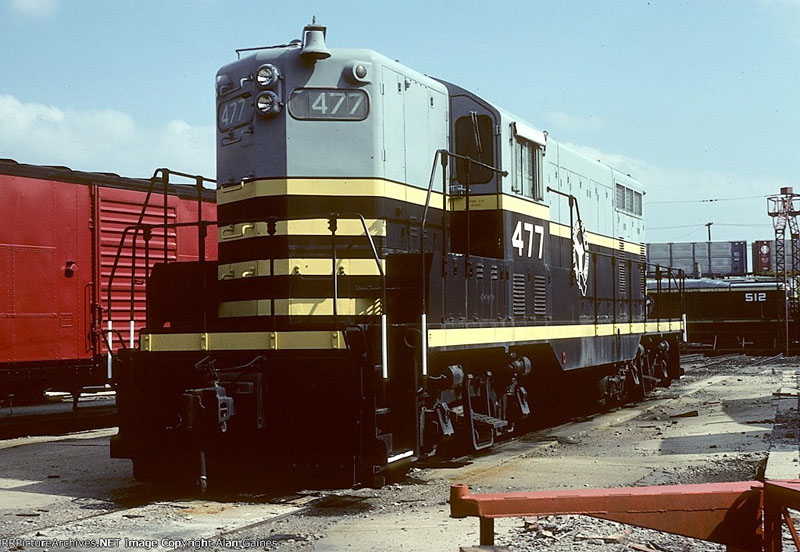
In August, ROPX 1320 was leased to Richardson Seeds Canada, located in Yorkton, SK. This genset started life as an NW2 in 1949 at EMD La Grange, IL, and has worn many identities including Southern Pacific NW2 3210. It was only recently converted into a genset, and in mid-August CRO’s Jody Moore shot her in transit on CP in Minneapolis, MN.
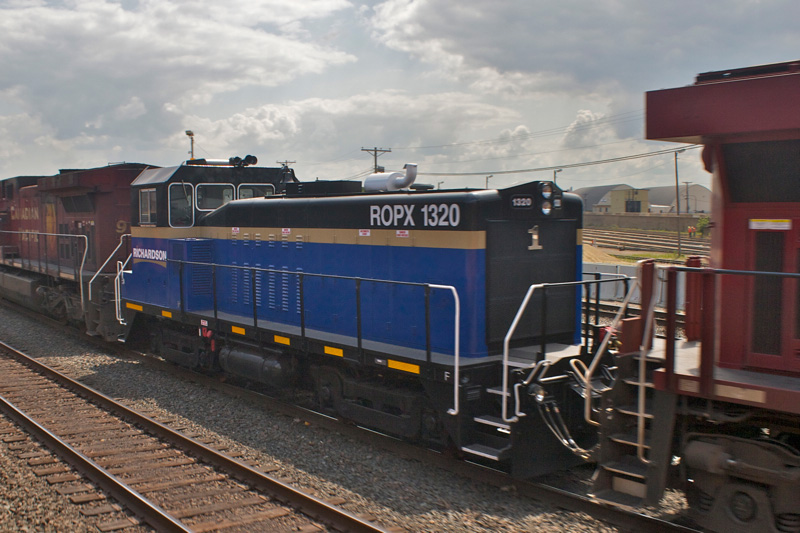
Cando Contracting GP9RM 7059 (in CN paint) arrived in Winnipeg, after departing the SRY Shop in BC in July. According to our sources , the locomotive is to be renumbered and repainted into Cando Contracting corporate livery and renumbered into the CCGX 4600-series.
Operating for their sister company, Prairie Rail Solutions, Prairie Dog Central Railway owned ex-Grand Trunk GP9 4138 is seen departing the west end of the CP yard in Winnipeg, June 1, 2013. Rugby tower is no longer in operation. All moves within the Winnipeg yard limits are now controlled by CP RTC in Calgary. (Jeff Keddy Photo)
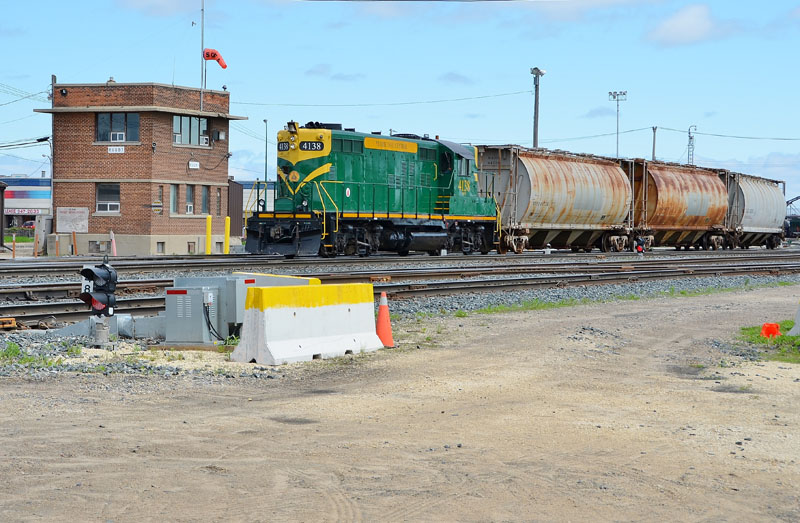

The first week of September, CITX SD40-2 2794 departed Montreal DIT on CP, enroute to the ONTARIO SOUTHLAND RAILWAY (OSR), for some repairs at the Salford Shop. After which the locomotive is destined to ZLT in London, ON. Walter Pfefferle shot her Salford, ON on September 11th, after she had arrived on the OSR. Richard Marchi shot the cab interior when CITX 2794 was stored on CP in Montreal.
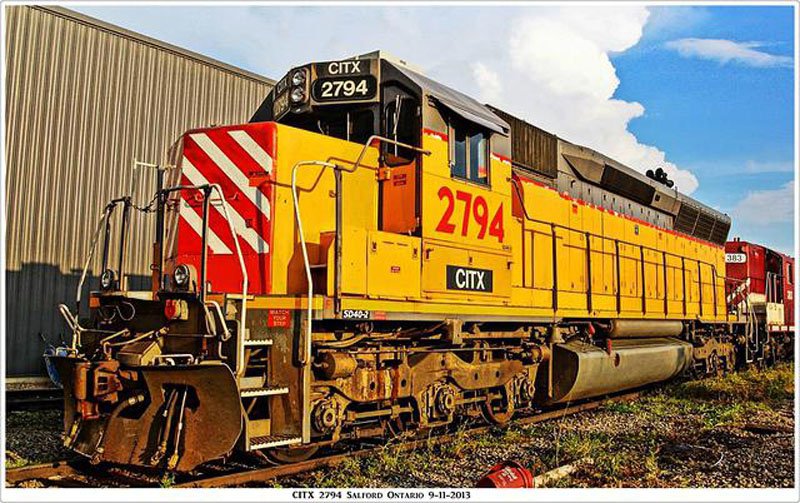
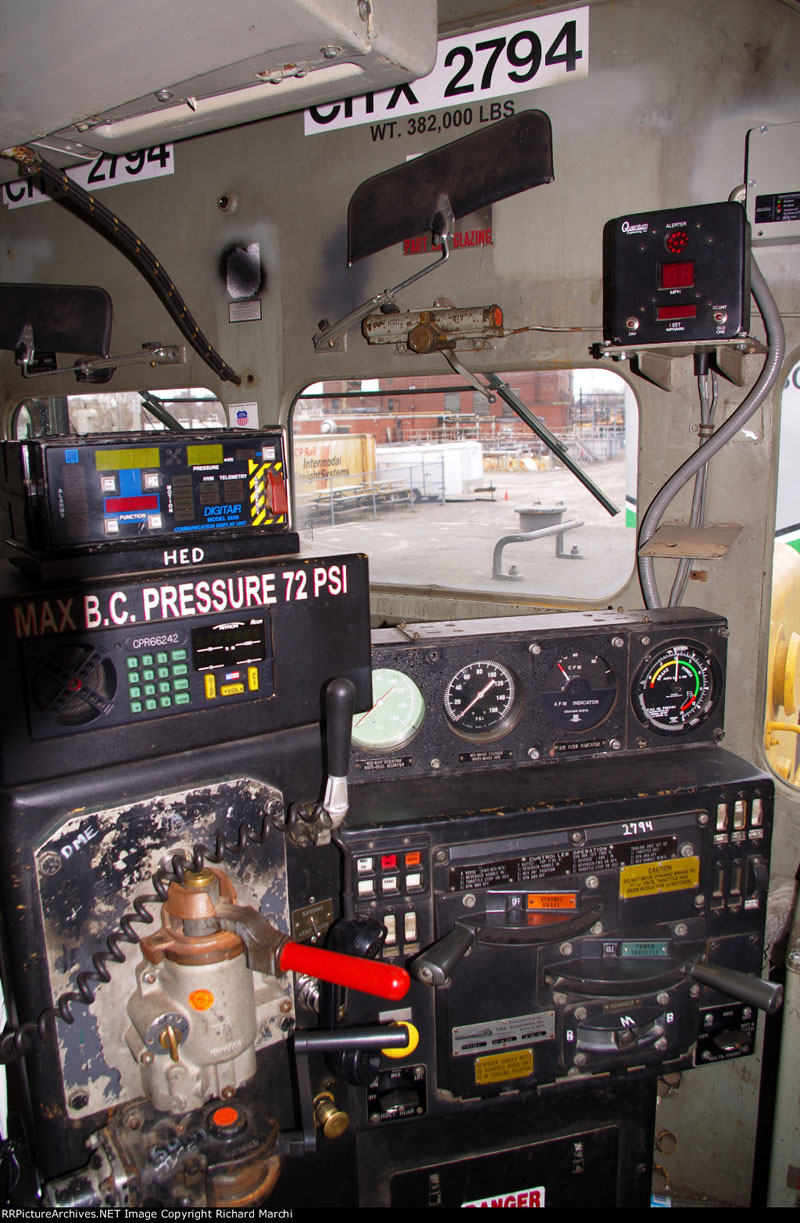
Ontario Southland Railway (OSR) FP9Au 6508 back in service, and on August 2nd, was lashed up with OSRX M420W 644. Walter Pfefferle snapped the consist at Beachville, ON.
History: CNR 6508 was built by GMD London as an FP9A in November 1954. In June of 1978, it was transferred to VIA, remaining in service until it was rebuilt in June 1984 by CN Pointe St. Charles Shop as a FP9Au, returning to VIA on July 8, 1984 as 6305. Surplus to VIA’s needs, the unit was sold in 1994 to Les Trains Touristque du Saint-Laurent (TTSL) for operation east of Ville de Quebec. When this operation shut down the FP9 along with the TTSL train set was sold privately in May 1997 to be operated by the Waterloo & St. Jacobs Railway. While in WSJR service, 6305 was renumbered back to its original CN road number 6508 and named “Spirit of St. Jacobs”. After the demise of the WSJR operation the train set was stored at VIA’s Toronto Maintenance Centre (TMC) in Mimico until part of the train set, including 6508 was sold to the West Coast Railway Association. By August 2012, the WCRA, electing not to incur further costs of moving equipment west to Squamish, sold 6508 privately for operation on the Ontario Southland Railway. Ontario Southland Railway found 6508 to be in operable shape internally, and put the unit into service quickly … her first assignment on the former CP St. Thomas Subdivision. Still wearing the colours of then former TTSL/WSJR once an OSR paint scheme is applied, it will be the eighth livery worn by this FP9! (Two in CN service (red, black & grey after 1961) , three for VIA, and one each for TTSL and WSJR.
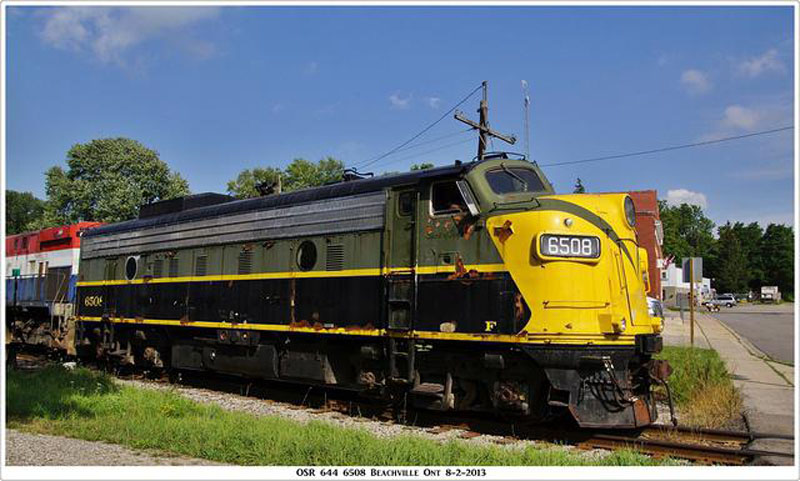
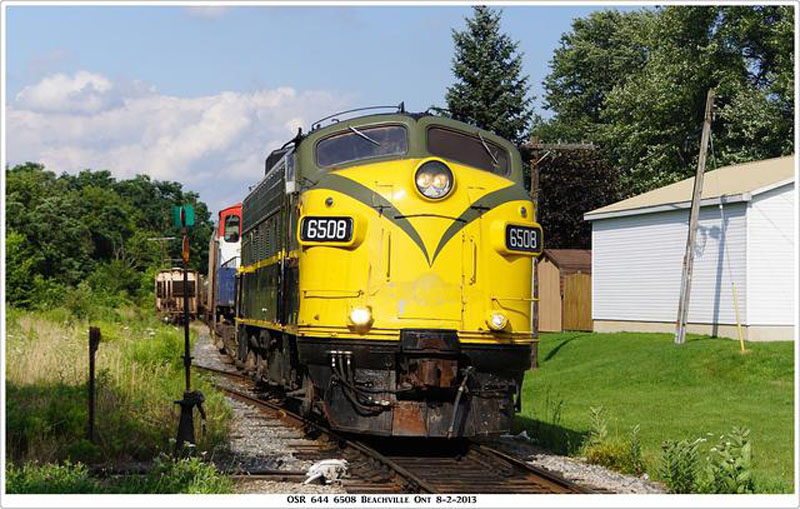

Video: http://youtu.be/PD5Q6MzDz_0
Walter also clicked OSR S13 500 and 502 at Ingersol on August 8th.
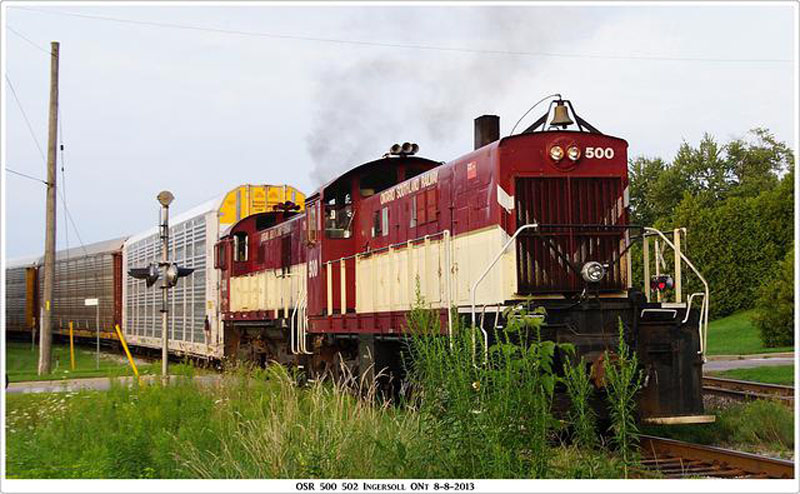
On August 14th, CP leased their TEC train to the Orangeville Brampton Railway to do geometry tests on the right of way. CP GP20C-ECO 2205 led Canadian Pacific TEC Train ran on the 36 mile Owen Sound Sub. to Orangeville, ON located North-West of Toronto and is operated by the Orangeville Brampton Railway. It later moved to Coteau, QC on the VIA Alexandria Sub to O)ttawa, and then went to Montreal in late August. (Photo by Steve Thomas)
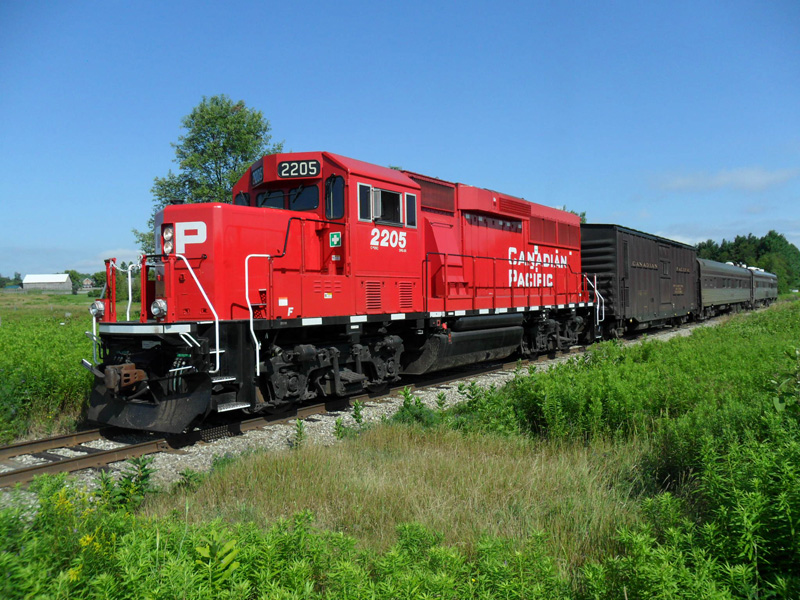
James Lalande reported Quebec-Gatineau (QGRY) GP35 2008 and SW1500 1501 have been reassigned to the Huron Central (HCRY). Two others QGRY GP40 Slug 800 and GP40-2 Mother 3800 were seen on HCRY train to Sudbury, ON as well in July.
In late August, a scrapper in Port Colborne, ON (INTERNATIONAL METALS) located on the Trillium Railway, purchased six retired CP SLUGS numbered CP 1012, 1013, 1024, 1152, 1156, and 1159.
National Steel Car (NSC) in Hamilton, ON, has been contracted to build railway tank cars and the railway will have many cars to move. The tank car bodies will be built at Trenergy in St Catharines, ON who build boilers and other pressure vessels. The tank car bodies will then be taken down the street in St Catherines to Canadian Erectors where they will be placed onto new railway frames and trucks which they fabricate. The semi finished cars will be then taken by Trillium Railway(Port Colborne Harbour Railway), for forwarding to National Steel Car (NSC) in Hamilton for finishing and painting. I can confirm Can. Erectors is this week working with Trilluim to revamp and upgrade the track under their large overhead yard crane. This new business production may have Trillium Railway moving between 12-16 cars at a time, and as the entire cars are built locally which is great economic news for the City of St. Catherines, ON.
Cando Contracting (CCGX) GP9RM 4418 was renumbered to 4615 and was supposed to go to go to Sarnia, ON to operate on a 40-mile shortline, but the deal fell through. CCGX 4615 was then moved to Toronto and returned to Winnipeg on August 5th. CCGX GP9RM7059 is also in Winnipeg for renumbering as well arriving from the SRY.
ONR SD75I 2103 (Train 213) runs around her just set off empties, while Resolute's recently rebuilt SW1200RS 1305 (ex-CN) couples up to those empties at Iroquois Falls August 16th. (Mike Robin Photo)
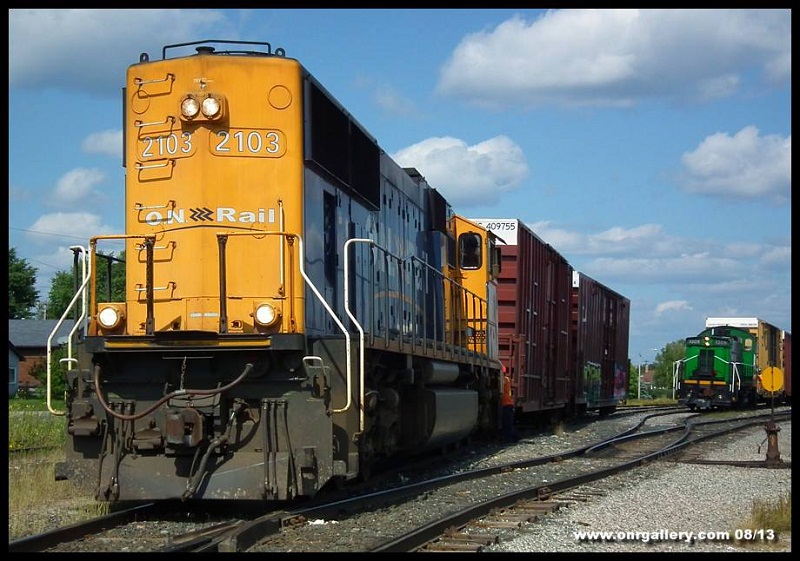
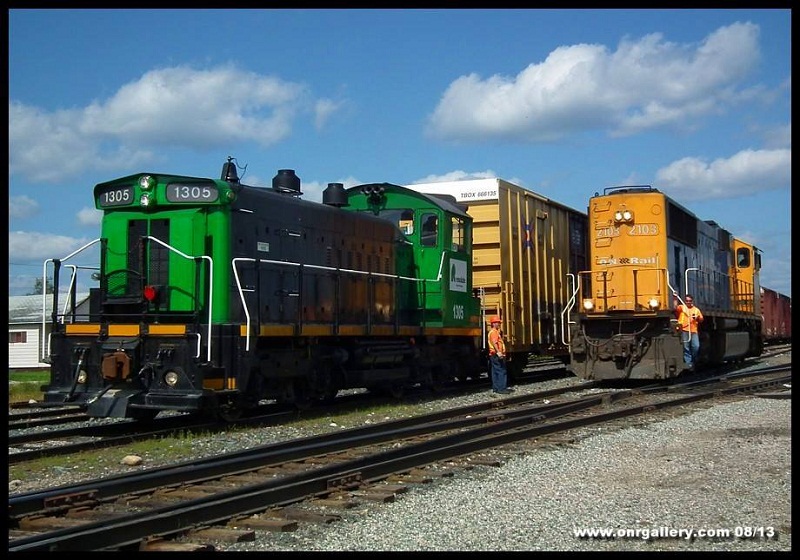
Train A40121-30 had three ex-Quebec North Shore and Labrador Dash 8-40CM’s, (QNS&L 401-402-402), and were labeled as AEX 100017-100018-100019, and are waybilled to Enola, PA. They departed Enola on Sept 8th and at press time were headed South on the NS Lurgan Sub between Harrisburg, PA and Hagerstown, MD. The new owner is The Andersons Inc, and the units are believed destined for Kentucky. The Andersons Inc. always use a 6-digit number series on their locomotives.
CN train 401 departed Joffre, QC at 12:00 noon east bound for Montreal, and then went south to Rouses Point, NY. The Dash 8-40CM trio have GE 7FDL engine rated at 4400 HP. As QNS&L rostered only three of these full-cowled GE’s, and they were getting on in years, built back in 1994, the railway decided to dispose of them. Eric Aucoin snapped these images of the trip at CN Taschereau Yard August 30th, just prior to being interchanged with CP (St-Luc Yard),and billed to (D&H) Mohawk Yard, NY, and then over NS Enola, PA. AEX 100017-10019 are ex 401-403 respectively. All photos are been taken on CN property with permission. Regarding the turned in DITCH LIGHTS: Devon Generous point out QNS&L operates on winding tight S-Curves so the ditch lights are turned inward to help illuminate the curves.
On August 30th, Francois Jolin photographed the trio southbound on CN #401 crossing the Richelieu River on the CN Ste-Hyacinthe Sub near St-Bruno, QC with CN 2230, 2440, 4730 and AEX 100017-018-019 DIT.
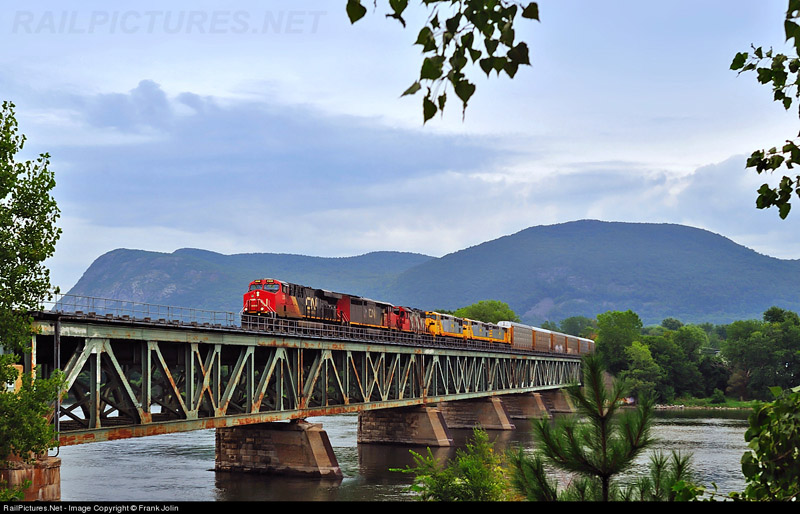
QNS&L VIGNETTES: When still new on June 11th, 1994 Robert Palmer photographed QNSL Dash 8-40CM and an SD40 with a high capacity fuel tank preparing an iron ore train at the Labrador City Mine.
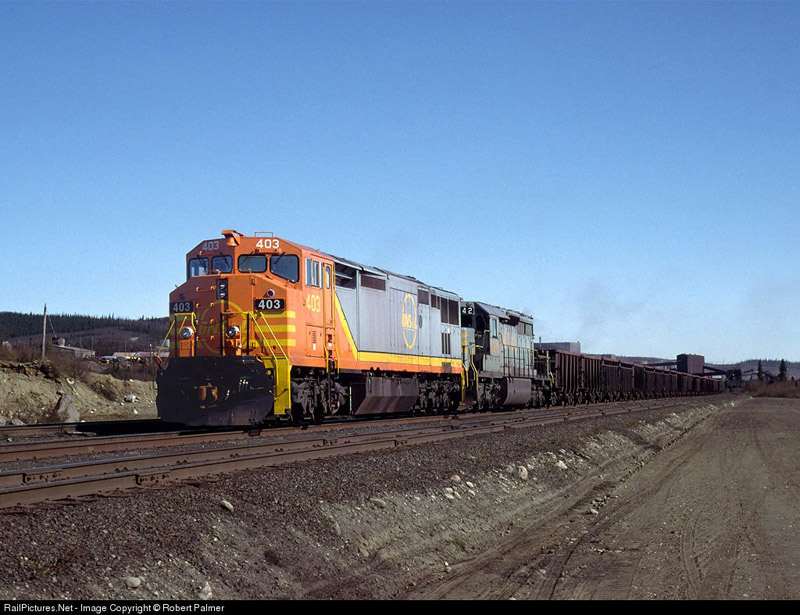
On April 23rd, 2008, Darrell Krueger shot QNSL 401 as the mid train helper units with the famed Draper Taper comes through, sandwiched between the IOC ore cars, from the Wabush ore cars, north of Sept-Iles, QC.
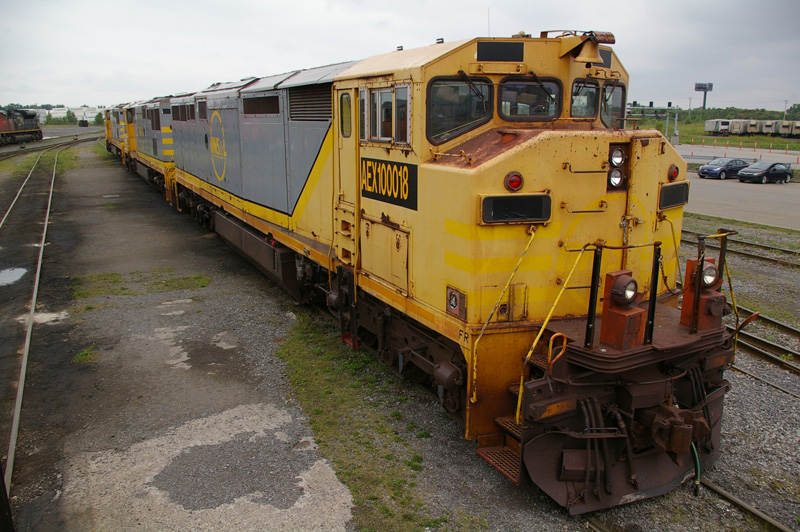
Damaged POM RP20BD 1002 was snapped by Eric Aucoin in Taschereau Yard August 30th following a collision at the Port of Montreal, and likely headed back to RELCO in Albia, IA for repairs
.jpg)
In early August, four of the CAD Railway Industries rebuilt CP SD60’s in storage on CP were activated: CP SD60M 6262, CP SD60 6251, and 6247 were in service on lease to Quebec-Gatineau (QGRY), In late-August CP 6247 departed the QGRY and is now in Expressway service for testing. Francois Jolin snapped this terrific lash-up of three SD60s (CP 6251, 6262, and 6247), leading an empty CP train over Quebec-Gatineau (QGRY) trackage rights on the Trois-Rivieres Subdivision (Quebec City to Montreal), on July 31st.
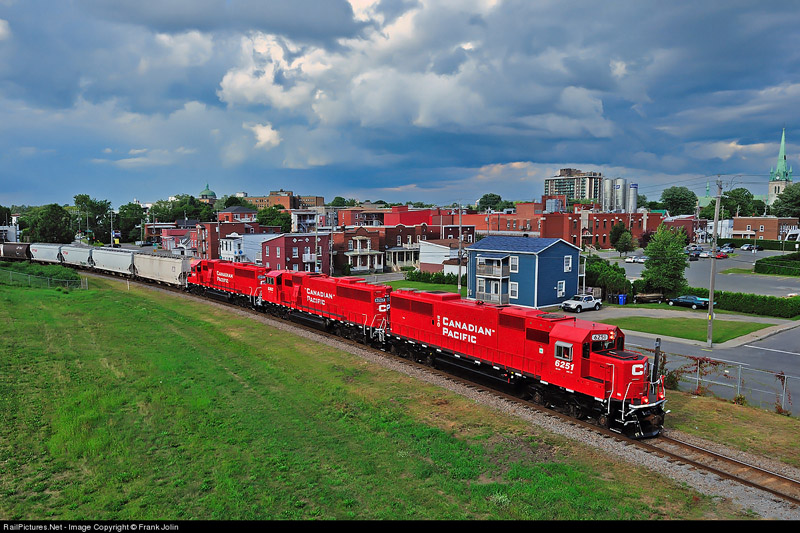
CP 6262, 6251 and 6247, operated on several grain trains on the QGRY and were returned to Montreal as 4th, 5th and 6th units on a QGRY Windmill train. They then departed on a CP Westbound and went all the way all the way to Thunder Bay repaying Horse power Hours owed to CP by QGRY. The trio returned to Montreal and back on the QGRY on the next grain train. The CP SD60M was never on the lead during the first half of the month, however when standard cab SD60 (CP 6047) was returned to CP, QGRY did use the SD60M as a leader. As of August 30th, the pair had departed QGRY and the following four units CP 6247, 6248, 6251, and 6262 were working on the CP Expressway train for fuel and oil testing. If anything goes wrong with them, they will be sent to CADRAIL for tweaking. When testing is complete the quartet will be returned to storage, or lease.
The first week of August, Pier-Luc Boilard photographed CP SD60M 6262, CP SD60 6251, 6247 and QGRY SD40-3 6908, 6920, 6904 and QGRY2302 leading train #90, a long 120 car train (mostly empty grain hoppers) returning westbound over QGRY trackage at Pont-Rouge, QC.
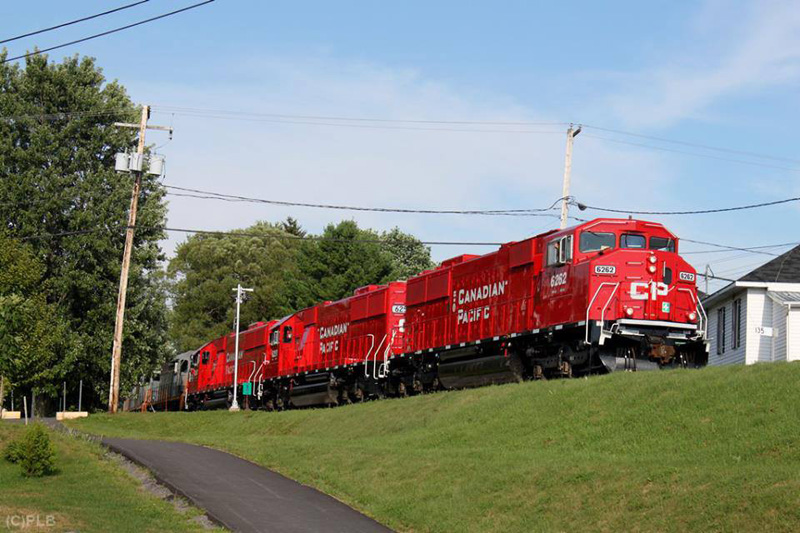
VIDEO of train #90 with CP SD60’s on QGRY trackage at Pont-Rouge, QC: https://www.youtube.com/watch?feature=player_embedded&v=NWQ3m4Jdgck
On August 12th the railway at the centre of the rail disaster in Lac-Mégantic, Que., was given no authorization to operate in Canada after the Canadian Transportation Agency pulled its certificate of fitness. The order, issued August 12th came after the agency reviewed the company and found Montreal, Maine & Atlantic Railway doesn’t have enough third-party liability insurance, or the funds to pay for the self-insured portion, both of which are requirements to operate Canada, stating, “It would not be prudent, given the risks associated with rail operations, to permit MMA and MMAC to continue to operate without adequate insurance coverage.”
Then a week later the decision was over turned when MMA provided documentation they indeed had proper insurance to operate. The government has allowed MMA to operate in Canada until November 2013.
Montreal, Maine & Atlantic (MMA) Train 710 was snapped by Richard Deuso at Newport, VT. August 29th, one of a limited number of trains were operating on the MMA in August.
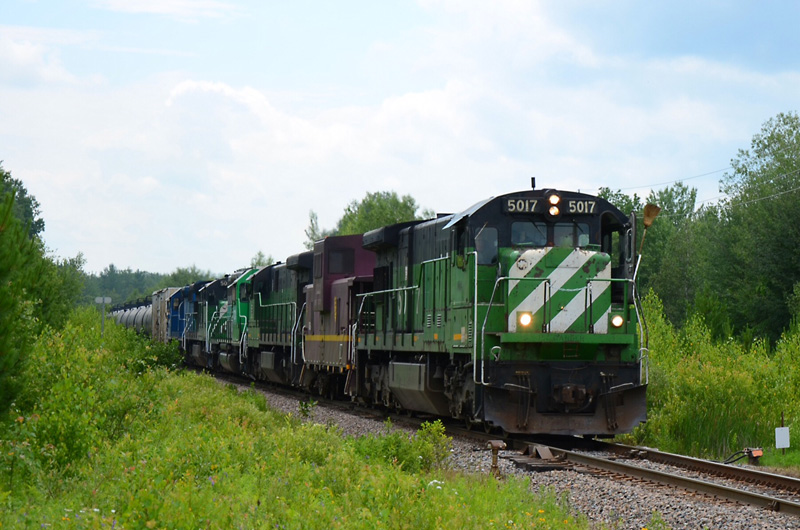
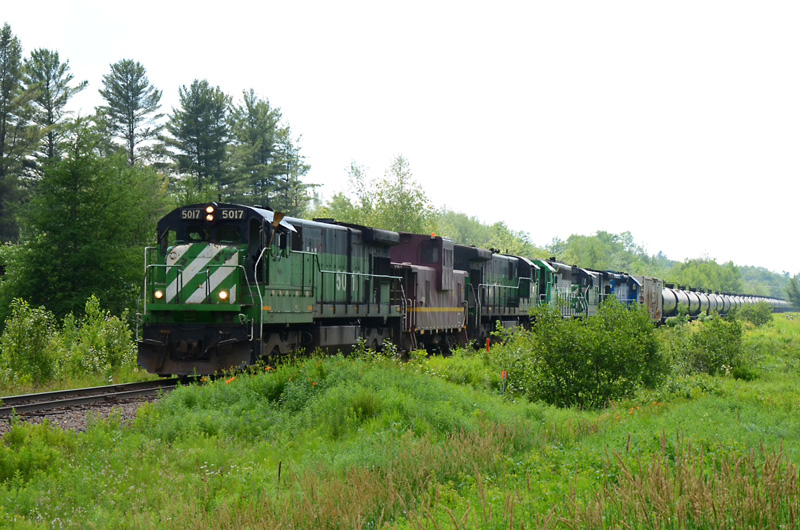
The agency, which acts as an independent regulator, issues certificates of fitness based on a railway's ability to secure enough third-party insurance to operate. According to the CTA, there are few players, around 30 to 40 companies, involved in rail insurance, and the industry is highly specialized. Rail companies of similar size to MM&A in North America usually have between $5 million to $50 million in coverage.
The agency said no railways covered under federal regulations have exceeded the cap on third party liability policies in the past 10 years, but the huge losses in Lac-Mégantic have raised questions around how able those policies are to fully cover the impact of a catastrophic event.
On August 19st, it was announced that Irving Oil Limited of Saint John, NB, was interested in purchasing the MM&A. The railway has a lot of traffic with over 100 small industries on the line, and of course bridge traffic.
On July 6, an unmanned train operated by MM&A rolled down a hill, derailed and exploded in the centre of the town in Quebec's Eastern Townships. A total of 47 people were killed in the blasts and the centre of the town was levelled. Recovery and cleanup operations have been underway since. Several investigations, including one by the Transportation Safety Board and another by Quebec provincial police, are still ongoing. In early August, faced with mounting lawsuits threatened and filed in Canada and the U.S., as well as a mounting cleanup bill, MM&A applied for and received bankruptcy protection from its creditors.
In light of that court decision, the government and the municipality handed over responsibility for the environmental cleanup of the devastated downtown core to a construction management company, Pomerleau Ltd.
While there is no indication that track conditions had anything to do with the derailment last month, but the Montreal Maine and Atlantic (MMA) was the subject of more than a dozen internal bulletins prior to the July 6th derailment (in company records) warning train crews to slow down on their main line in Quebec because of poor track k conditions. Train crews were instructed to follow speed restrictions at 23 locations on the MMA mainline between Montreal and Lac Megantic, QC. Mainly because of this derailment and loss of life, the public concern over rail safety in Canada has spiked in recent weeks all hinging on the (TSB) federal accident investigation currently underway to uncover the cause of this disaster.
Rail traffic began running through Lac-Mégantic the third week of August, however it came as no surprise on August 5th when the MM&A announced the railway had decided it will stop hauling oil all together. “It’s proven to be more trouble than it’s worth, and that’s putting this mildly,” said company chairman Ed Burkhardt a month after a runaway MMA train exploded downtown, killing 47 people and leveling much of the town.“ We don’t plan to continue with oil transportation. That traffic is going to go other ways, not over our lines,” he said. The train that derailed on July 6thwas loaded with crude oil that was extracted from oil fields in North Dakota, and was in transit to the Irving oil refinery in St. John, N.B.
Two days later on August 7th, the MM&A announced they had filed for bankruptcy protection in Canada, and Chapter 11 bankruptcy in the U.S., amid a flurry of lawsuits and growing cleanup costs the company estimates will surpass $200 million. Under Chapter 11, the railroad can continue operation. In Canada, MMA presented a petition in Quebec Superior Court seeking relief from its creditors under the Companies’ Creditors Arrangement Act. “It has become apparent that the obligations of both companies now exceed the value of their assets, including prospective insurance recoveries, as a direct result of the tragic derailment at Lac-Megantic,” Ed Burkhardt said in a statement. “A process under Chapter 11 and the CCAA is the best way to ensure fairness of treatment to all in these tragic circumstances.” Federal Transport Minister Lisa Raitt said the announcement by MMA does not mean the company is “off the hook” in their responsibilities to help the people of Lac-Megantic.“We will work with the Province of Quebec to ensure that the clean-up continues and that the people of Lac-Megantic continue to receive the support they need. We have already announced $60 million to assist in the response and recovery, and to help the local economy rebuild,” said Raitt. Documents filed in U.S. court say MMA has between $50 million and $100 million in estimated assets and between $1 million and $10 million in estimated liabilities. The bankruptcy-court filing was posted on the website of Maine’s Bangor Daily News.In Canada, court documents filed under the CCAA by Montreal, Maine & Atlantic Canada Co. state it has just under $18 million in assets. The CCAA allows companies protection while they work out ways of avoiding bankruptcy.
At month end the most damaged part of Lac-Mégantic, the “Red Zone”, remains off limits, as work crews haul away debris and continue to dig up oil contaminated soil. MMA resumed service in August opening the east side of the blast site, but the area around the western end of the tracks, which form a Y-shaped junction around the crash site was completely flattened during the explosion. That section of track will take longer to reopen. “I can’t hazard a guess on when,” Burkhardtsaid.“I do hope people will see some carloads of paper, wood pulp, logs and automobiles and that kind of stuff go through Mégantic, before too long. And I would hope that they wouldn’t see that as some kind of threat to them,” he said. If we can start to see an uptick in freight volume, we won’t be laying anybody else off, and we actually might start to call people back to work,” Burkhardt said. The railway had laid off 24 employees in Quebec and 64 in Maine after the explosion. “Well, there have been a bunch of layoffs, so they’re not happy,” Burkhardt said, when asked how the company’s employees were doing. At press time, minimal freight service had returned and many laid off MMA workers were back on the job.
To recap: In the morning hours of July 6th, a runaway Montreal Maine & Atlantic Railway (MM&A) loaded crude oil train heading eastbound derailed and then exploded in the center of the community. The ensuing fire and explosions killed 47 people and destroying several businesses and homes. Thousands more people were evacuated from their homes, with barely time to escape the inferno. The series of tragic events that led to the derailment began to unfold late in the evening of July 5th, when the 72-car MM&A train stopped at Nantes for a crew change at 23:25, Nantes is about 10 kilometres west of Lac-Mégantic. The one man crew tied the train down, and went off to the hotel. Shortly after, a resident reported a fire in one of the train’s locomotives, and the Nantes volunteer fire department was called to the scene. The MM&A was also contacted and they dispatched their own personnel to the train as well. Not long after, the fire fighters had extinguished the locomotive fire and the scene was deemed safe by all the personnel involved. However, at some point between midnight and 01:00 the loaded unmanned train began moving downhill towards Lac-Mégantic. At 01:15, massive explosions erupted in downtown Lac-Mégantic after a dozen tank cars mid-train derailed. It was been reported, but not confirmed that the derailing crude oil cars possibly struck loaded propane cars that were sitting on an adjacent siding. Also, tragically, the derailment and explosions occurred in close proximity to a popular bar, the Musi-Café, where many patrons were still enjoying the warm summer evening, both inside and on the patio. The MM&A engineer, Tom Harding said he heard the explosions from his nearby hotel and made his way to the front of the train where he uncoupled the non-derailed cars and moved them as well as the locomotives to safety further down the line. Fire fighters spent the next few days battling the fire and intense heat before they could even begin to get close to the centre of the derailment scene. At that time, 40 people were originally reported missing, however that number slowly climbed as the reality of the situation became evident. Also, the Red Cross arrived in the town and assisted evacuees at PolyvalenteMontignac de Lac Mégantic, which is a local high school.
The trains locomotives MMA C30-7 5017, RC van VB-4, MMA C30-7 5026, CITX SD40-2 3053 MMA C30-7 5023, and CEFX SD40-2 3166 were photographed by Richard Deuso one day before the tragedy. These somewhat eerie images show the Montreal Maine & Atlantic (MMA) Crude Oil Train moving eastbound between Brookport, QC and Magog, QC on the afternoon of July 5th, the day before.
The Transportation Safety Board (TSB) recovered the event recorder from the lead MM&A locomotive the following day, and Canadian Prime Minister Stephen Harper visited the devastated community as well as its effected citizens and likened the disaster scene to a “war zone.” By July 9th, a majority of the residents who were forced out of their homes were being allowed to return, Lac-Mégantic’s mayor had announced. However, another 800 people had to remain evacuated because of work that was continuing in the centre of town, which was the area most affected by the explosions. Four days after the incident, Edward Burkhardt the Company Chairman of the MM&A Ed Burkhardt finally visited Lac Mégantic to view the damage first hand. Angry residents and the media greeted Burkhardt at an impromptu press conference that was hastily put together in the middle of a residential street in the town. He was heckled by onlookers for waiting four days to appear in Lac-Megantic as others demanded answers for the runaway train and subsequent derailment. Burkhardt answered questions and suggested that engineer Harding failed to set the brakes properly on the train before he left to go to the hotel in Lac-Megantic for the night. On July 10th, Quebec’s Premier Pauline Marois met with town officials and laid-out a compensation plan for survivors of the disaster. In the day’s following, all of the affected residents were allowed to return to their homes and they were informed they no longer had to boil drinking water. Officials had closed off the downtown center until July 16th, when reporters werefinally allowed to view and film the damage in the “red zone” first hand. In late July, Lac-Mégantic's mayor, Colette Roy-Laroche said the devastated town had yet to receive any reimbursement from MM&A for the millions of dollars spent cleaning-up after the derailment. Legal notices had been sent by both the town and the Quebec government over several days, asking MM&A to pay eight different contractors that they had hired for the initial cleanup. The town had to reportedly pay more than $4 million earlier in July when crews working at the derailment site had threatened to walk off the job because they weren’t being paid. Roy-Laroche said Lac-Megantic had spent $3.6 million since then. “Without the help of the Quebec government, the failure of the MM&A to fulfill its obligations would have put the town of Lac-Mégantic and its citizens into an intolerable situation,” said Roy-Laroche. Burkhardt said the company’s insurer had agreed it’s liable for the costs, however legal issues had held up the process and they were still waiting for insurance funds themselves. “We’re unable to fund that out of our own cash,” said Burkhardt in reference to the $4-million bill from Lac-Mégantic, which had since increased to $7.8 million. On July 25, investigators with the Sûreté du Québec raided the MM&A’s headquarters in Farnham, QC as part of their investigation into possible charges of criminal negligence that led to the runaway train and its derailment. As well, Quebec court records indicate that Yannick Gagné, the owner of the popular Musi-Café that was destroyed in the accident sought authorization on July 15th to begin a class-action suit against MM&A’s parent company Railworld. In addition, Lac-Mégantic’s lawyers and provincial officials were reportedly reviewing other options for getting reimbursed, including launching lawsuits of their own, along with the dozens of effected families who have started the process of filing claims against the company in both Canada and U.S. Meanwhile, the company had continued to lay-off employees during July due to the incident and the union representing railway workers said more lay-offs were possible for employees in Quebec. Also, the union said 24 of the MM&A’s 75 employees based in Farnham, Quebec had been laid-off since the accident. The MM&A as it stands, may not survive the increasing financial cost of the mounting environmental cleanup expenses, and of course the pending lawsuits still to come.
Preliminary TSB report on the MMA derailment at Lac Megantic, QC:
http://www.tsb.gc.ca/eng/enquetes-investigations/rail/2013/R13D0054/R13D0054.asp
The Quebec Provincial Government ordered the Montreal, Maine & Atlantic Railway and fuel companies involved in the July 6th derailment that killed 47 people in Lac-Mégantic, to pay for cleaning up crude oil that spilled in the town and surrounding lakes and rivers. Quebec Environment Minister Yves-Francois Blanchet invoked powers under a provincial law to force the companies to take financial responsibility for fixing environmental damage. The order names MM&A, fuel-services companies World Fuel Services Corp., and Western Petroleum Co. Some 35,000 barrels of oil leaked from the cars when the train derailed, according to estimates by the Quebec government. Most of that has already been removed but Blanchet says the rehabilitation work must continue nonstop and without cost to taxpayers. The government has no estimate yet of how long it will take or how much it will cost. “We are in unknown territory,” Blanchet says. “We don’t know exactly how long it will take, but we do know the full restoration will be done.”He says the companies are expected to respond to his order today. The town of Lac-Mégantic’s legal representatives wrote previously to MM&A to request it handle the cleanup job.Investigators from the Canada Transportation Safety Board are expected to release an update later this week on their probe of the accident.
HISTORY: Owned by American Shortline operator Railworld, the Montreal Maine and Atlantic Railroad (MMA) was formed back in 2002, from four former Iron Roads shortlines; Canadian American Railroad (CDAC), Bangor and Aroostook (BAR), Quebec Southern and Vermont Northern. Around 25 trains per day operate over 800 miles of track in Maine, Vermont and Quebec over ex-BAR, and former CP trackage in the Maritimes, and they have trackage rights on CP into Montreal. They interchange with CP, Pan Am Railway,New England Central (NECR), and New Brunswick Southern (NBSR). MMA recently increased their traffic substantially whit a new contract to haul crude oil trains between CP and NBS and they operate a fleet of classic older locomotive models: B30-7, B39-8E, B23-7, SD40-2, GP9, and F40PHR.
LATE NEWS: A second MMA train outside parked east of Lac Magantic, QC for two days with only 5 handbrakes (only the MMA locomotives) were applied on a grade. Even though they parked in a siding and were protected by a derail, that would be insufficient to stop the train from moving on to the main on a grade. GLOBAL NATIONAL NEWS STORY: http://shar.es/zPeNQ.
CSX recently ordered cranes to be delivered to their two facilities operated by CSX Intermodal Terminals. Three RTG’s will be installed in Valleyfield, Quebec, Canada, and one RTG in Chicago, IL USA. All four cranes will be delivered before October 2014.
The Port of Montreal (POM) sold four EMD MP15AC switchers (POM 8303, 8304, 8405, and 8406), to GATX Capital Corporation this summer. They wer to be sent to Metro East Industries in East St Louis, IL for overhaul, and are renumbered to GMTX reporting marks. Mark Mautner shot GMTX 304 at MEI in August.
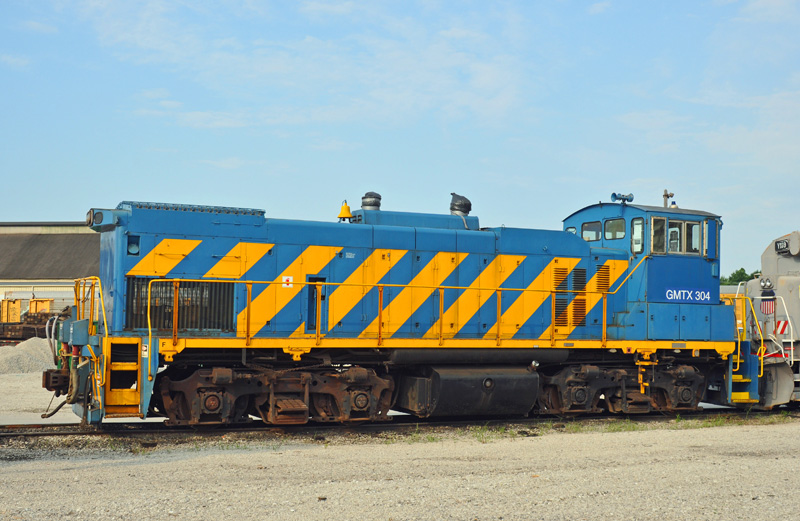
NBSR 6318, HLCX 6332 and an unidentified HLCX ex-UP GP38-3 haul 60 loads of pulpwood and woodchips eastbound through Danforth, Maine on 8/31/13, This train originated in Oakfield, ME on Maine Northern Railway, and is headed to McAdam, NB on New Brunswick Southern Railway. Irving recently announced the construction of a new stud mill at Ashland, ME to be served by its Maine Northern Railway subsidiary, so expect more traffic to come down from the north to Eastern Maine Railway.
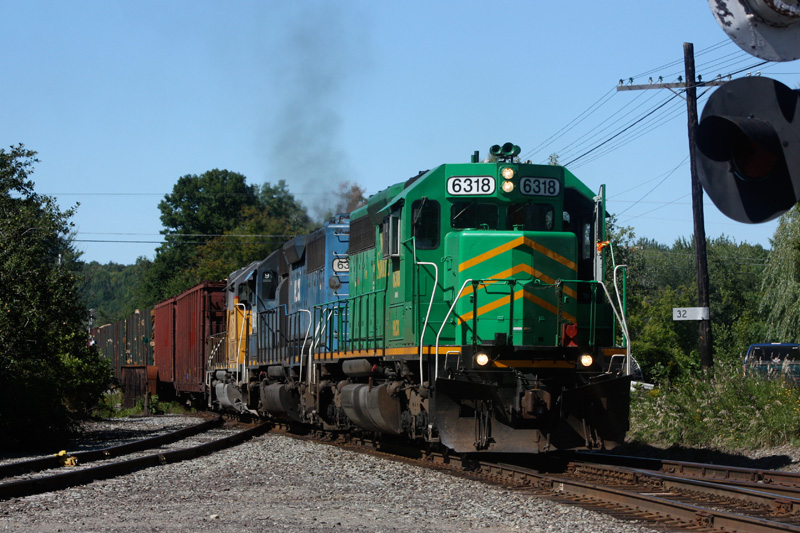
NBS 6318, HLCX 6332 and an unidentified HLCX ex-UP GP38-3 haul 60 loads of pulpwood and woodchips eastbound through Danforth, Maine on 8/31/13, This train originated in Oakfield, ME on Maine Northern Railway, and is headed to McAdam, NB on New Brunswick Southern Railway. Irving recently announced the construction of a new stud mill at Ashland, ME to be served by its Maine Northern Railway subsidiary, so expect more traffic to come down from the north to Eastern Maine Railway.
MM&A C30-7 3000 is preparing to depart Millinocket, ME for Brownville Junction, ME with Radio Control Car VB-2 and CITX SD40-2 leaser 3057 on 8/19/13. MM&A is still operating one-man crews in Maine despite the head of the U.S. Federal Railway Administration recommending(rather than requiring) ending the practice on MM&A. It is rare these days to catch anything at the once-busy Millinocket yard. It is primarily used for storage of MM&A boxcars, and sees the passage of the East Millinocket branch local several times a week, as well as Maine Northern Railway/Eastern Maine Railway's pulpwood and woodchip train from Oakfield, ME to McAdam, NB, operating south of Millinocket on MM&A trackage rights en route to EMRY/NBSR.
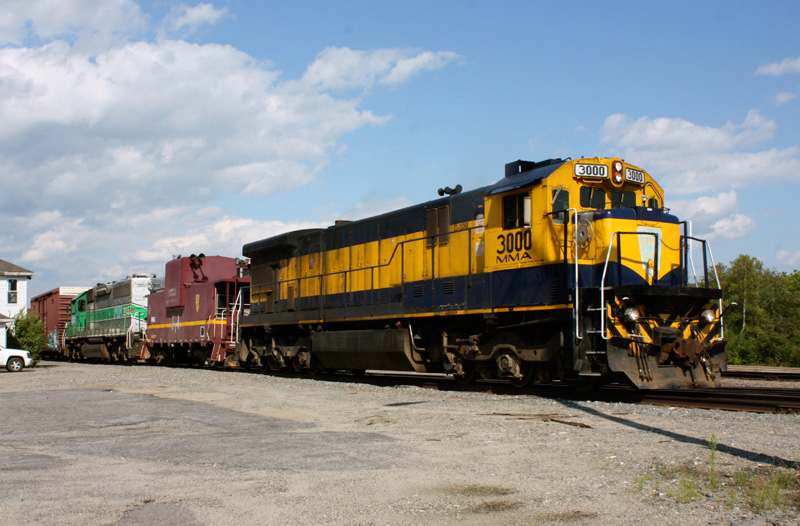
MM&A C30-7 3000 is preparing to depart Millinocket, ME for Brownville Junction, ME with Radio Control Car VB-2 and CITX SD40-2 leaser 3057 on 8/19/13. MM&A is still operating one-man crews in Maine despite the head of the U.S. Federal Railway Administration recommending (rather than requiring) ending the practice on MM&A. It is rare these days to catch anything at the once-busy Millinocket yard. It is primarily used for storage of MM&A boxcars, and sees the passage of the East Millinocket branch local several times a week, as well as Maine Northern Railway/Eastern Maine Railway's pulpwood and woodchip train from Oakfield, ME to McAdam, NB, operating south of Millinocket on MM&A trackage rights en route to EMRY/NBSR.
New Brunswick Southern Railway/Eastern Maine Railways westbound manifest crosses the Mattawamkeag River bridge at Bancroft, ME en route to Mattawamkeag, ME on 8/13/13. Both lead unit GMTX GP38-3 2657 and second out SD40-3 HLCX 6332 are ex-Conrail. However, GMTX 2657 began life as a plain GP38 on Penn Central before moving to Contrail. Trailing unit is NBSR/HLCX leaser SD40-3 6318.
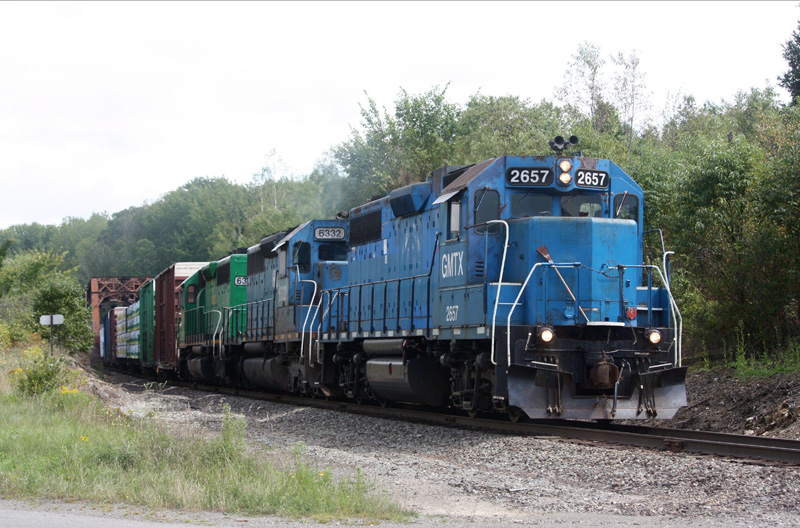
New Brunswick Southern Railway/Eastern Maine Railways westbound manifest crosses the Mattawamkeag River bridge at Bancroft, ME en route to Mattawamkeag, ME on 8/13/13. Both lead unit GMTX GP38-3 2657 and second out SD40-3 HLCX 6332 are ex-Conrail. However, GMTX 2657 began life as a plain GP38 on Penn Central before moving to Contrail. Trailing unit is NBSR/HLCX leaser SD40-3 6318.
© CRO September 2013
